 Facebook
Facebook
 X
X
 Instagram
Instagram
 TikTok
TikTok
 Youtube
Youtube
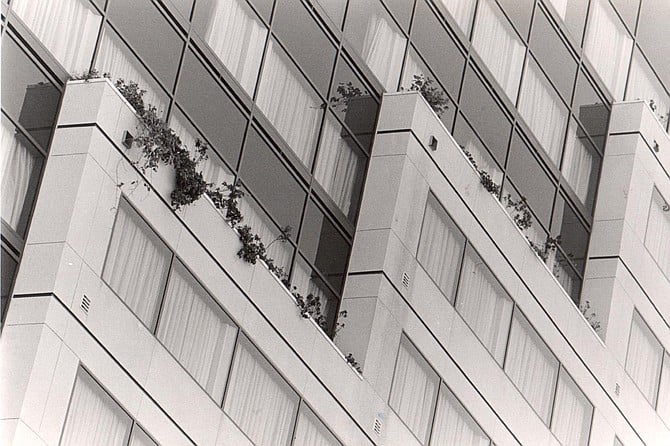
Late one hot afternoon, while freeways were snarled, I set out aimlessly by “surface streets" through the belly of the L.A. basin. With no other mission than to gawk at an alien landscape, I began my tour at the gargantuan Los Angeles International Airport, where the new Century Freeway is finally beginning to rise — a concrete forest of pillars so massive, so tall, so closely spaced that they cast a dense shadow over the neighborhoods far below.
I followed the new freeway’s route eastward to where a fleet of yellow earth-movers pounded through what once were streets lined with 1920s-era wood and stucco homes. Signs there heralded the coming of the freeway and solicited bids for construction work from “women-owned contractors."
On the margins of the new 12-lane right-of-way, each anonymous town merged with the next. One after identical other linked by streets that in impolite Los Angeles are called “commercial strips”: fast-food joints, tire shops, computer stores, and whatever else landlords could sign up. As I traveled east, the illuminated signs repeated themselves at irregular intervals. McDonald’s, Burger King, Taco Bell, 7-Eleven...
San Diego has its own, emerging versions of these strips. Yet they remain finite, confined perhaps to ten miles or so at most. In Los Angeles, the strips have no end.
Nobody follows these streets to their natural conclusions. No one watches the commercial areas finally fade into dismal warehouse districts. Few people cross the railroad tracks, head into tawdry residential neighborhoods left over from the Great Depression. These broad commercial avenues turn to rivulets as they proceed east, bump their way under freeways, flow around concrete-lined river channels.
Most of L.A is a monument to industry’s detritus. Once you have seen it at ground level, climbed down into the city’s grimy pores, you appreciate San Diego’s comparative virginity. After a summer in L.A., it’s difficult to return to the old mission town and be anything other than grateful that, in your absence, only a few more condos have been built in North Park; that only a couple of thousand more cubic feet of earth have been cut away from the hills in back of Scripps Ranch; that rush-hour drive time between Del Mar and downtown is only ten minutes longer than seven months ago.
But what would happen if you turned your back to the city for a longer period of time? What would you find upon your return? As it advances in age, the streets, the highways — its very arteries — would surely move more slowly. What else would you find? Study the present’s symptoms. That San Diego is good for another ten years seems the most hopeful prognosis. Still, the troubling etiology is there for each citizen to study.
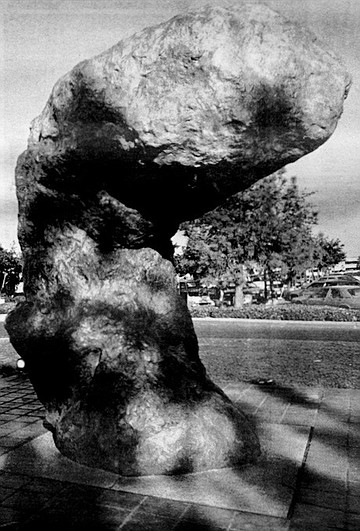
Once a breathtaking stretch of bluff tops overlooking wild surf, Torrey Pines Mesa, a major gateway to San Diego, has been converted into a corporate theme park: sterile office buildings politely called “headquarters”; gene splicers; nuclear fusion experts; corporate takeover artists. All their dismal work is conducted in aseptic interiors.
These used to be city-owned Pueblo Lands, part of a once-enormous legacy of open space handed down to the citizens by visionaries who wrote the city charter. Beginning in the Fifties, politicians found ways to circumvent the will of the voters and sell off large chunks for cheap development. Torrey Pines Mesa might have been a vast public park. It is now subdivided into oversized lots on which a surfeit of tilt-up concrete buildings have risen.
The worst of these is the distinguished Scripps Clinic, where the world’s millionaires seek exotic medical care. A 15-foot-tall sculpture resembling a distended colon — its official name is Okeanos — was recently unveiled on the lawn in front of the clinic, which itself resembles a 1964 New York World’s Fair pavilion. Tawdry concrete surfaces bearing the Scripps Clinic rectangular logo act as a barrier between the highway and the ocean far below.
South of the clinic, UCSD has turned the old Blackhorse Farms, for years a genteel riding stable, into a warren of second-rate condominiums, pushed right up to the edge of the busy highway.

UCSD’s rude amalgam of undistinguished architecture was generally thought to be enhanced by the addition of the new engineering center and what appears to be a promising bookstore and humorously postmodern student center currently under construction. The Career Service Center, an unpainted concrete block box accented by jolting mirror-glass, looms above legions of job-seeking students poring over the latest employment announcements on display cases planted in the front yard. This building, south of the Central Library, is clearly meant to warn graduates that the outside world they will encounter is not all enlightenment and beauty.
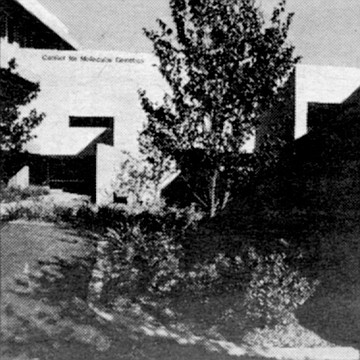
And on a regrettable par is the Center for Molecular Genetics — another concrete block, on-the-cheap, recent addition to UCSD. One hopes that the research conducted within these austere cement walls near the Medical School will reflect a natural elegance forsaken by UCSD’s proud designers.
Here’s a real mystery: Hoping to attract a sophisticated clientele, the posh new Omni Hotel spends about $30 million to build a pastel appendage to the Horton Plaza shopping center. The lobby resembles the inside of a movie house from the Twenties, but enough opulent brass and classy rubber plants have been installed to satisfy the most demanding Drexel/Lambert broker’s tastes.

Exorbitantly expensive granite cobblestones adorn the outdoor driveway upon which tool lengthy white limousines and souped-up silver Borsches. Even mega-millionaire Larry Lawrence, proprietor of the grand Hotel del Coronado, recently blessed the lavish premises by roasting himself at a splashy fundraiser there.
But what's that out there in the driveway? That tall, blue translucent plastic thing? A trade show’s misplaced exhibit? A new-wave oil derrick? A work of Art?
It’s The Blue Obelisk. The undeniably blue phallus is surrounded by an impressive plastic wading pool, about which iridescent green and blue fish and dolphins prance. It all would look much better served in a coconut with the requisite paper parasols and red straws.
Lately architects don’t want us to look so much at the basic structure of their work as at the limestone and the snazzy brass doodads they attach to distract us from the dismal truth: There’s nothing there but an oversized box. Two of urban Mission Valley’s relatively new additions serve as bad examples:
The Doubletree Hotel. From the hotel’s regulation stucco exterior, a corner has been coyly pulled back to reveal... some green-colored windows! Coquettishly distracting for those trapped in interminable traffic on Interstate 8, a tease in poor taste nonetheless.
That long, ugly brown building in Mission Valley. Yes, that rectangular monstrosity west of the 805 overpass, the Rio Vista building, was once camouflaged by ridiculous multihued tentlike somethings. In reality, it was just another ridiculous office building. With all its colorful finery stripped away, it’s more honest but still moribund. The addition of the clunky brown Marriott chain hotel next door isn’t going to help.
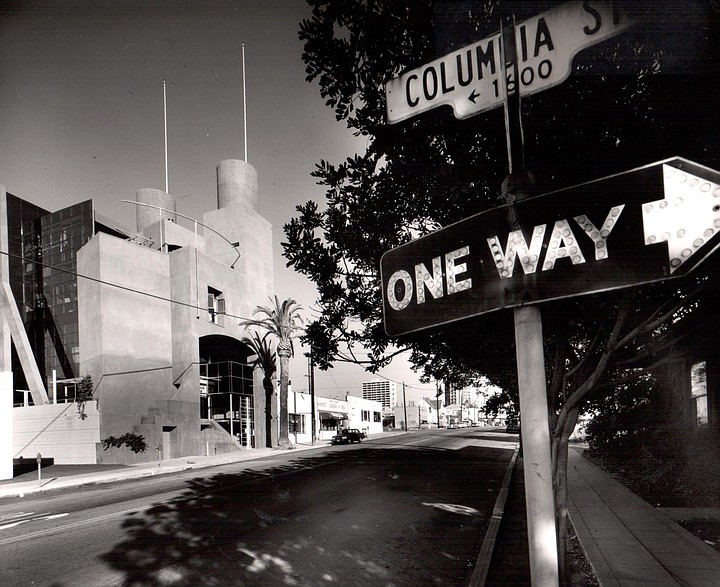
Eccentric architect Rob Quigley can’t be cited for understatement. The Beaumont, a double-barreled office building he’s managed to foist on the downtown area near Fourth and Cedar, looks as though it should be put into active service as a water tank for the San Diego & Arizona Eastern Railway. Although Quigley’s earlier works have had their moments, they have not worn particularly well.
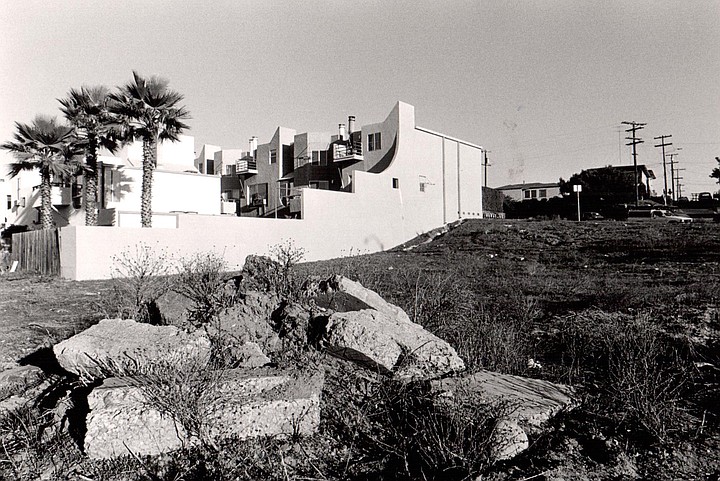
Case in point: the small Pacifica apartment complex on West Point Loma Boulevard near Nimitz. It once radiated warmth and good cheer — qualities somewhat innovative in the field of condominium design. Today these Point Loma units are clad in dismal battleship gray. Their once-flashy red awnings are tattered or missing, and the driveway through the tiny complex is now as cheerless as the prison yard at Alcatraz.
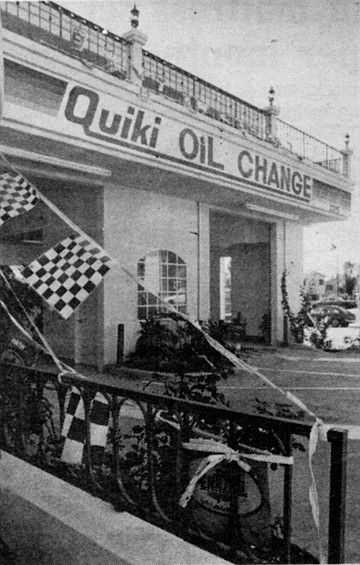
The commercial buildings at Garnet and Bond deviate from the norm in the obsessive attention paid to their tacky detail. The mail’s prominent location on one of the most traveled boulevards of Pacific Beach makes it hard to miss. It would be unkind to Tijuana to suggest that that mall’s brown stucco, multibalconied facade was inspired by the bold shop fronts along Revolución. That street of painted burros and musty strip shows at least has some character.
The mail’s two primary tenants are Quiki Oil Change and Sheepskin. Not satisfied with the building’s garishness, Quiki has hung a red plastic banner about 20 feet long and 5 feet wide announcing that its oil changes take ten minutes. Reinforcing this vital message are multicolored plastic flags strung around a stairway leading to the second-floor offices (none of which appear rented at the moment). Perhaps would-be tenants are put off by sharing the premises with a place that offers hasty lubrication. Yet the builder has included some unusually charming amenities, such as a small flower garden along the sidewalk, lined with miniature Mexican-style wrought-iron rails — another acknowledgment of the building’s debt to Latin American style.
A sigh of relief was breathed by many when Paul Thoryk, the native San Diegan who authored the skillful renewal of downtown’s Old Columbia Square, escaped federal drug-related charges last month (after a judge threw the case out of court for lack of evidence). But what he’s done to the Mission Beach Plunge is clearly a crime. The smoking gun:

Thoryk and his partner, a real-estate development company owned by San Diego Gas & Electric, found a co-conspirator in San Diego City Hall, which solicited and approved Thoryk’s remodeling of the historic swimming pool over the objections of thousands of Mission Beach residents. With the support of then-councilman Mike Gotch, an erstwhile planner and environmentalist now employed by development tycoon Doug Manchester, Thoryk’s group tore off the elegant facade of delicate moldings and destroyed utterly the dignified building that once encased the swimming pool. In its place they fashioned a sterile white shopping center, imprisoning the plunge within a featureless stucco and glass box. A trendy health club — Fitness Advantage at the Plunge — has usurped the swimming pool’s locally treasured old Mission Beach Bath House identity. The bulky surrounding structures slink around the site in embarrassment. Void of Thoryk’s light, engaging touches, the new building is replete with overpriced gift shops and chocolate-chip cookie stores common to regional shopping malls. On a recent afternoon, a baby-boomer drinking establishment full of yups sipping imported dry beer as they waited for disk jockey Larry Himmell was the only place in the barren complex that evinced any life.
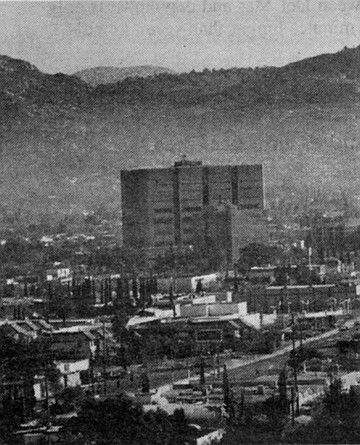
Mr. Thoryk, this jury finds you guilty of a first-degree affront to architectural dignity. You are hereby sentenced to spend weekends painting the decrepit roller coaster skeleton that adjoins the mall. Furloughs are suspended until you just say no to vandalizing charm and history in a town that has precious little of either.
The East County Regional Center was once called the “superblock” in homage to its ravenous appetite for space in the tiny, hillbilly heart of downtown El Cajon. Composed of three oversized, drab brown buildings hulking over a haze-shrouded valley, the regional center on East Main provides us several more reasons to be happy we approved Proposition 13. First there’s the six-story “civic center” housing the innards of El Cajon city government, done in textured brown brick.
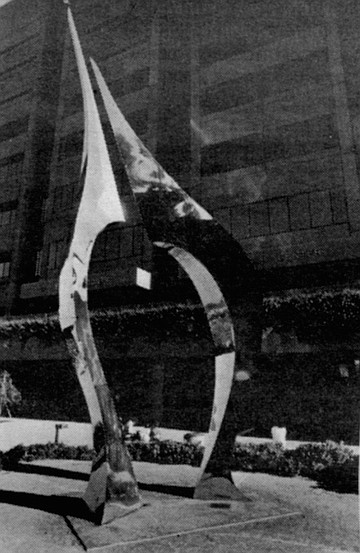
Then comes the menacing brown stucco regional center itself, eight floors of jail, courthouse, and related support functions. Finally, the performing arts center — a low-rise theater also colored brown. Two delicate stained-glass windows, relics from downtown San Diego’s Victorian-era courthouse demolished 30 years ago, are the theater’s only two mementos of bygone civility. This entire extravaganza is graced by the presence of a stainless-steel sculpture by James Russell. Entitled Interpoint, it resembles — startlingly, unexpectedly — a giant interuterine device. A local urban planning consultant with otherwise good taste recently defended this monolithic tribute to floated government by calling it “El Cajon’s only real landmark.”
Ernest Hahn’s contribution to North County commerce is a collection of uninspired aircraft hangars surrounded by legions of glittering automobiles. North County Fair, no doubt, makes plenty of money and makes it with as little concession to aesthetics as it can get away with. The center is built on what used to be a city park. To overcome voter resistance to what would become the largest megamall in the county, Hahn and his associates worked out a land swap between the cities of San Diego and Escondido that moved the park to the north — no sense wasting a busy freeway interchange on wildlife.

The original proposal, concocted for the benefit of Escondido voters, who had to approve the park transfer, portrayed the mall as a kind of rustic country retreat, the kind of place where shoppers could commune with nature as they ransacked the racks at Nordstrom. Then Jon Jerde, fresh from his many-colored stucco triumph at Horton Plaza, brought his celebrated architectural wisdom to North County Fair. His legendary love affair with stucco yielded a hellacious venue for the mass consumption of everything and anything — in short, a splendid monument to the U.S. trade deficit. Shoppers, oblivious to the mall’s sobering artistic statement, may appreciate North County Fair’s exotic trappings, such as the soaring emerald green granite-and-glass arch welcoming them to the northern facade of Robinson’s. It’s a fine architectural feature until it suddenly dead-ends when one gets through its doorway and finds that its windows are false fronts and that the majestic lobby doesn’t exist.
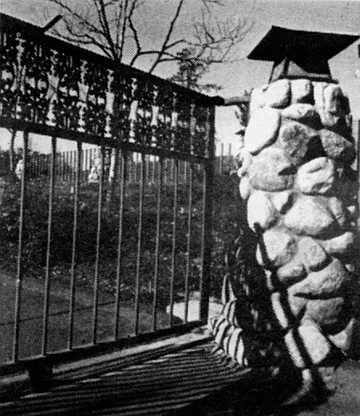
Doug Manchester claims a generous place in our hearts for having erected the Marriott (neé Inter-Continental) Hotel that all but obliterates a splendid view of the bay. He further endeared himself to the public by then naming all the hotel’s conference rooms and bars after his children. But the Manchester Mansion in La Jolla has carved out its own spot in our not hearts. This little casa sprawls across five choice acres at the top of Mount Soledad and enjoys a majestic view of the Pacific Rim — another piece of choice real estate Manchester would no doubt also like to get his hands on.
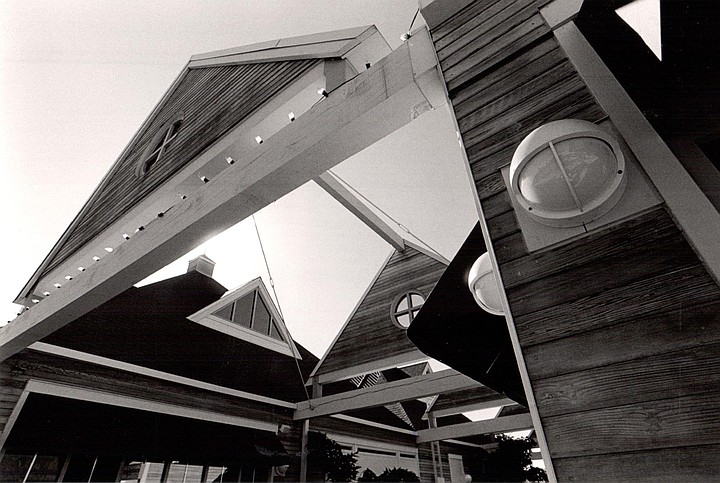
Seen by mortals only in newspaper photos (armed guards are rumored to protect the estate), a large grassy knoll shields the exclusive neighborhood from the stunning stylistic bravura that lies beyond the home’s imposing. Citizen Kane-style wrought-iron gates.
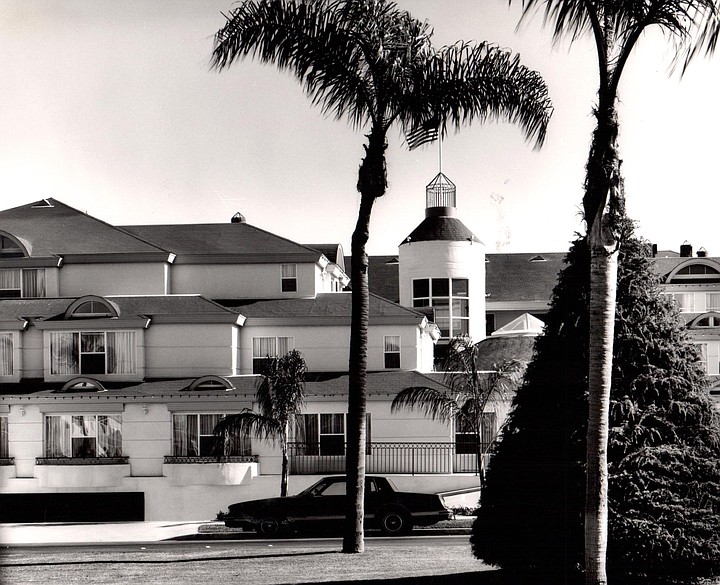
Coronado will soon be a Potemkin Village of cheap Hotel del Coronado replicas. A recent orgy of cloning has raised the Del’s signature cone-shaped red roof to stylistic obsession status. There is The Landing, a ritzy condo project on the bay that has taken great pains to duplicate even the balustrades and millwork of its inspiration on the other side of the peninsula (Larry Lawrence, the Del’s owner, should consider charging a royalty for each gable).
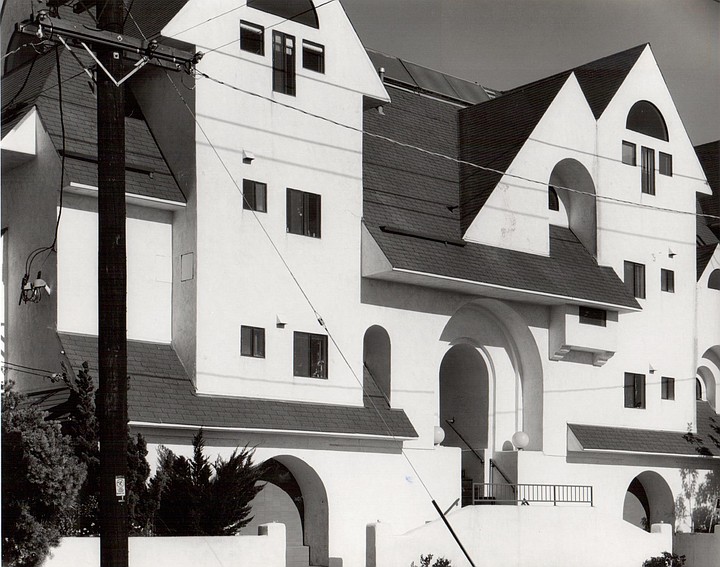
Another would-be Del-plicate is the newly opened Best Western Suites Hotel at the coroner of Fourth and Orange. In dubious yellow stucco, the hotel tries very, very hard to recapture the majesty of the old Victorian lady and, oddly enough, preserves neither the letter nor spirit of the century-old original.
A block away, an anonymous condominium complex at Fifth and Orange also attempts to ape the Del. It achieves a strikingly similar degree of success.
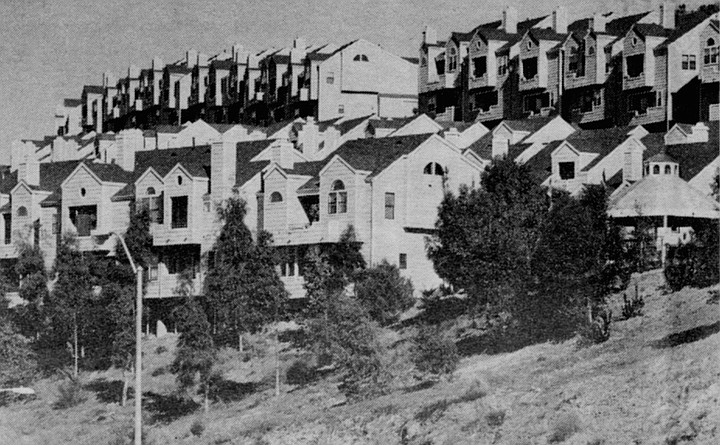
Above Interstate 15 near the Mira Mesa Boulevard exit rests a wedge of cheap lumber cobbled in warmed-over Cape Cod-modem design. In an attempt to hype the snob appeal implicit to its location (wedge o’ homes sits across the street from the Scripps Ranch K Mart), the development has been dubbed Nob Hill. The nob units, some of which (attention K Mart shoppers!) are still on the market, have been given high-ticket names like “Mark Hopkins” and “Fairmount.”
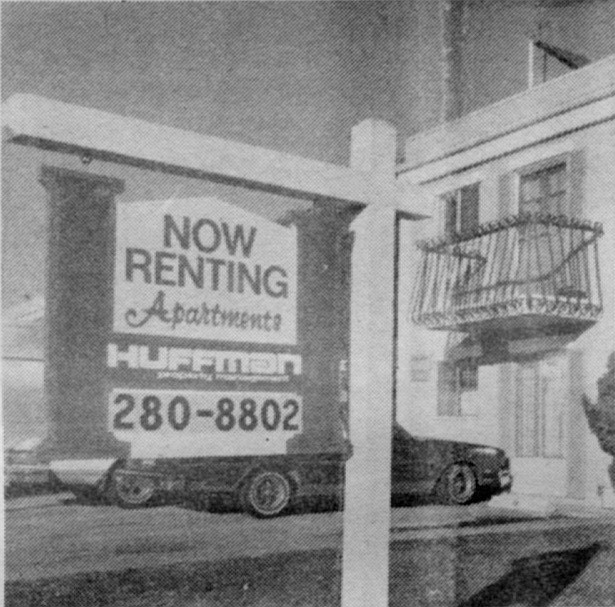
When interest rates shot through the roof a few years back, apartment developer Ray Huffman went bankrupt. But the Reagan era has been good to Huffman, and he’s returned with an admirable selection of moderate-rent, if anonymous, housing for those who haven’t yet made it to Nob Hill and have to settle for North Park.
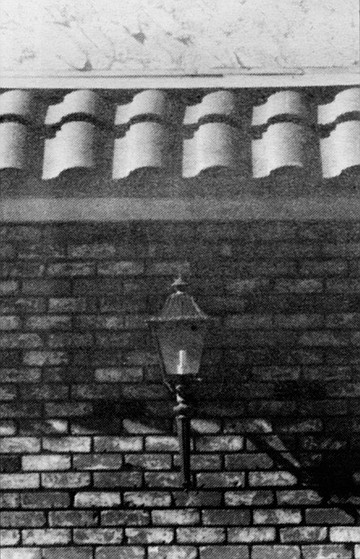
Ray’s competitors have, however, also jumped into the development fray, and suddenly it’s impossible to tell which belong to him and which to his imitators. As a service to the bewildered public, we offer this brief guide to Huffmania:
Textured stucco is de rigueur for exteriors, but heavily textured stucco is out. Spanish tile for Huffman roofs is still hot — but not to excess. Few chandeliers are in evidence; Huffman buildings prefer discrete recessed lighting wherever possible. Landscaping is kept to a minimum to conserve water and, perhaps incidentally, cash flow.
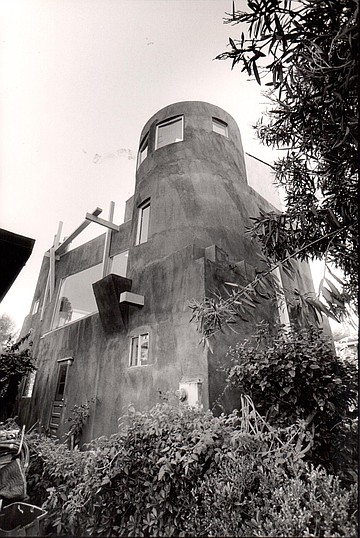
Poor Ray Huffman. Poor dull Ray. Poor dull, monotonous Ray. What if he met up with a guy like Tom Grondona? Nobody ever accused Tom of being boring. Especially not the irate upper-crust denizens of Point Loma, who know well just how exciting his architecture can be.
You remember Tom — Tom the enfant terrible of the local architectural scene, the winner last month of an official Onion for his iconoclastic conversion of a Kensington dental office into a symbolic molar. He started in 1976 on a hill in Point Loma with his own house, which he christened the Talbot Street Trainz. By today’s Grondona standards, the “Train” was a mundane trip to suburbia, remarkable only for the red plastic bubble that serves as the window on a “theater space.” Across the street from the Train, however, stands a silent witness to Grondona’s ultimate transition to all-out stylistic anarchy. Grondona entitled this one Tower to the Stars — a reference to the stairway that rises from the living room to a structure neighbors call “The Bed Box” (and which Grondona himself refers to as “The Queen’s Bedroom”), where the mistress of the house is said to obtain a stunning view of San Diego Bay and the stars above. All this is wrapped in rough, unpainted stucco, presenting a Huffmanish gray facade to an unimpressed world. It is chastening to realize that, at this very moment, Grondona is huddled over his work bench, sketching out his next attack on neighbors’ sensibilities whose biggest problem heretofore had simply been calculating their homes’ swelling equity.
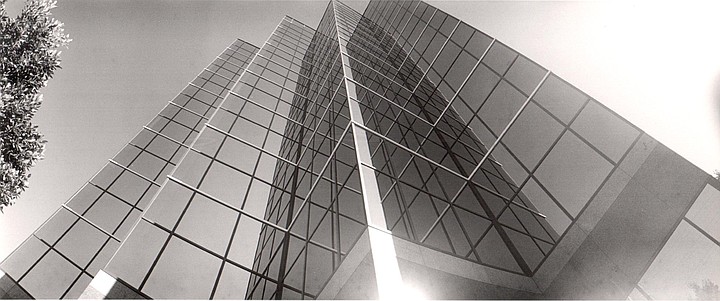
They may have names, they may even have tenants who think the places are swell, but to us they all look the same: mirror glass, tall and short, fat and stubby, concentric and linear, domed and flat, stuccoed and unstuccoed, eccentric and conventional. In the suffocating world of Mirror Glass, identity is just a reflection.
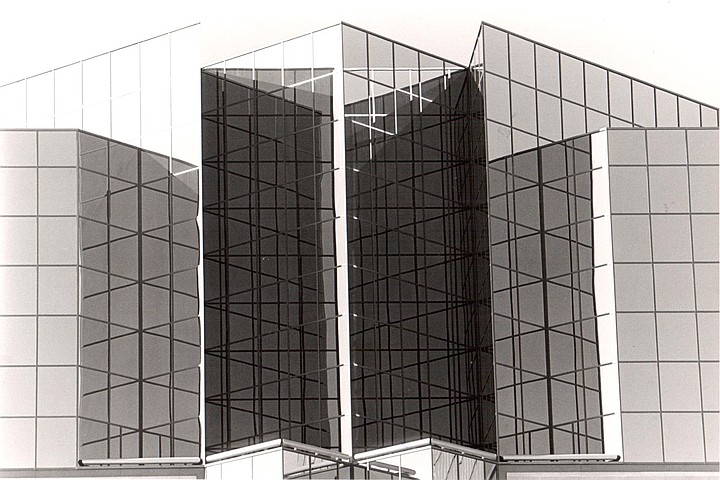
Freeways are damned if they are and damned if they aren’t. In North County, Interstate 5 is so popular it achieves gridlock during peak commute periods.
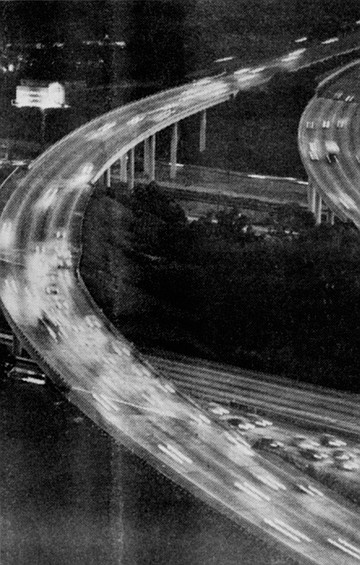
The dazzling headlights pouring down the hill from Sorrento Valley each evening do have a certain beauty. And like most things of beauty, they are most sweetly worshipped from afar. Trapped amid a thousand points of light, crazed commuters, oblivious to the dazzling spectacle that surrounds them, are rumored to tax the cellular telephone system to its limits.

At the other end of the spectrum, one finds the old state Highway 252 right-of-way in Southeast San Diego. Meant to connect Interstate 805 with I-5 just south of downtown, 252 followed the course of all roads built with good intentions. It crashed head-on into organized community opposition. But not quite before hundreds of houses were torn down and a barren strip eight lanes wide was cut through the neighborhood. Local officials have been trying to pick up the pieces ever since. While plans to build new housing never seem to reach fruition, the strip has evolved into an impromptu park lush with weeds and naked trees — a kind of post-nuclear east-of-Eden effect.
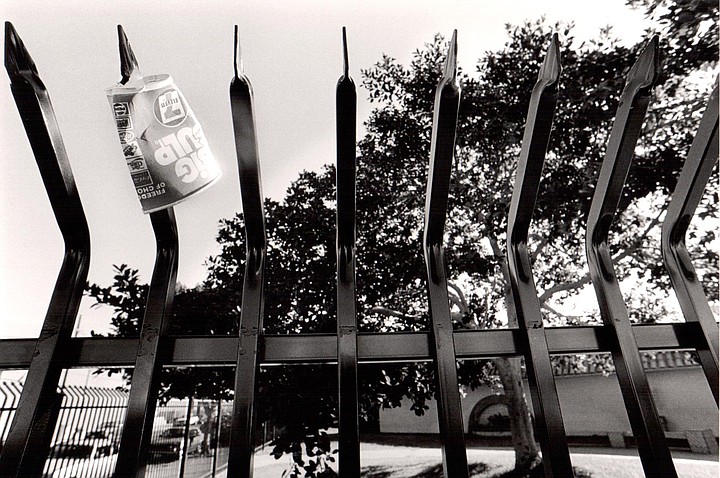
Several years ago, San Diego Gas & Electric had the pleasant idea of sprucing up one of its corner substations downtown (officially known as Urban Substation) with a vest-pocket park. This worked for a while, until a flood of homeless washed into the area, forced east from their traditional haunts, each of which had been redeveloped into a posh shopping mall that didn’t have room for them. The sight of scraggly bodies hanging out on the lawn of the tiny park at 14th and F was apparently not greeted with charitable smiles by the utility, and a nasty-looking spiked iron fence was recently erected to keep everybody out.
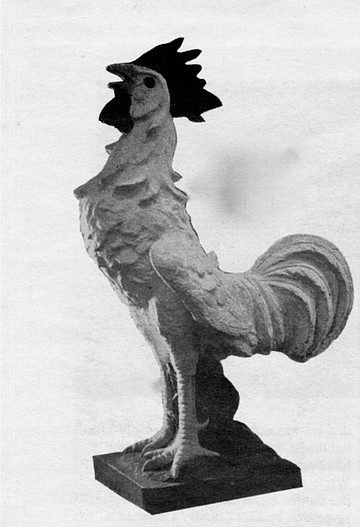
Once a Victorian landmark on the main highway between San Diego and Los Angeles, the Twin Inns in Carlsbad later became famous for the large plastic chickens perched in the parking lot to attract would-be diners. Today an enterprising developer has taken it upon himself to tack a terminally cute mini-mall onto the rear of the building, guaranteeing that future generations will regard the finely aged hostel as the best shopping center north of Seaport Village. (The chickens are being retained for historical accuracy’s sake.)

In the architecture biz, parking garages are necessary evils; some are more evil than others. The ones at Horton Plaza are particularly malevolent. Their naked eastern and southern exposures rudely insult the surrounding streets and are somehow never mentioned in the glowing write-ups about the mail’s “breakthrough” architecture that appear periodically in Sunset magazine and The New York Times. These bare flanks are supposed to be eventually hidden by a very skinny building, considerably less evil but so far nonexistent.
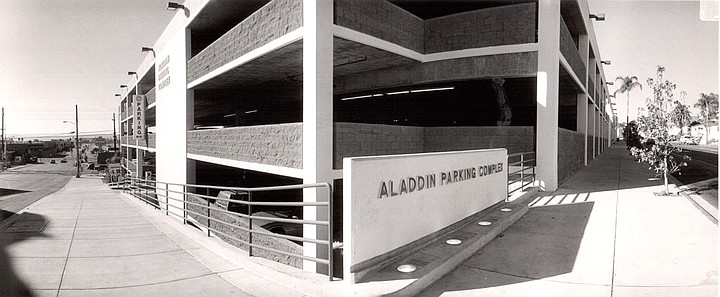
The burning question about the Alladin Parking Complex on Kettner Boulevard near the airport is why they call it that. It doesn’t look like a magic lamp. It did seem to appear magically out of thin air one day a year or so ago, so maybe if we wish real hard it will disappear as quickly.

Hospitals have made the parking garage another gruesome medical specialty. Two examples belong to Sharp Hospital in Kearny Mesa and Scripps Clinic at Torrey Pines north of UC San Diego. Sharp has attempted to soften its behemoth’s gross insult by attaching to the structure’s side planters filled with a bountiful variety of puny shrubs.
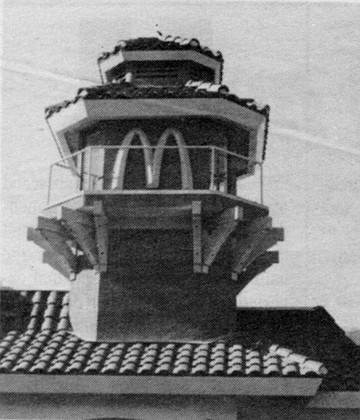
When Pea Soup Andersen’s moved south and built a perpetually rotating, true-to-life windmill at the corner of I-5 and Palomar Airport Road, San Diegans somehow believed some unnamed threshold of roadside kitsch had been breached, never to be surpassed. But McDonald’s, long-time arbiter of architectural taste and high-minded design, was not to be outdone. Hence its lighthouse-cum-mission-cum-deluxe hamburger stand across the freeway. While noteworthy, McDonald’s’ Mission del Burger by the Sea is diminished somewhat by Car Country Carlsbad’s breathtaking scope. Similar to the National City Mile of Cars, yet still special in its own right, Car Country has mercifully replaced the vast and numbingly repetitive fields of fresh flowers that once swept across the hills above the freeway.
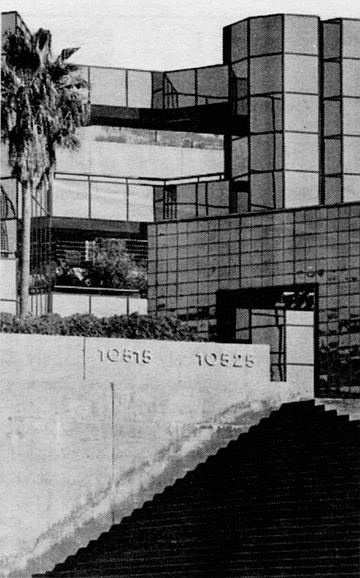
A chunk of hillside along I-805, south of its merger with I-5, was sliced away so a trendy architect could install transplanted palms, a black-colored waterfall (looking slightly less festive when turned off on weekends to save money), and those marvelous mirror-glass corporate buildings we can simply never, ever have too many of.
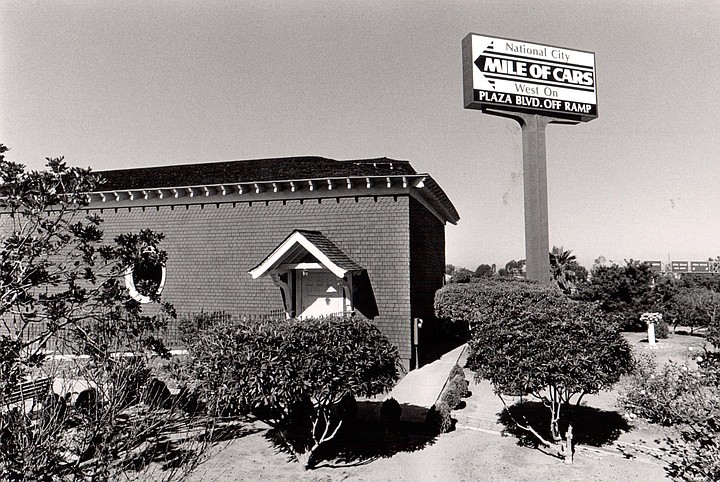
When city fathers wanted to restore the historic Granger Music Hall and found they didn’t have enough money to finish the job, they moved the building next to I-805 and graciously allowed the friendly dealers at the Mile of Cars to put up a sign advising motorists how to find National City’s second-most-historic attraction.


Late one hot afternoon, while freeways were snarled, I set out aimlessly by “surface streets" through the belly of the L.A. basin. With no other mission than to gawk at an alien landscape, I began my tour at the gargantuan Los Angeles International Airport, where the new Century Freeway is finally beginning to rise — a concrete forest of pillars so massive, so tall, so closely spaced that they cast a dense shadow over the neighborhoods far below.
I followed the new freeway’s route eastward to where a fleet of yellow earth-movers pounded through what once were streets lined with 1920s-era wood and stucco homes. Signs there heralded the coming of the freeway and solicited bids for construction work from “women-owned contractors."
On the margins of the new 12-lane right-of-way, each anonymous town merged with the next. One after identical other linked by streets that in impolite Los Angeles are called “commercial strips”: fast-food joints, tire shops, computer stores, and whatever else landlords could sign up. As I traveled east, the illuminated signs repeated themselves at irregular intervals. McDonald’s, Burger King, Taco Bell, 7-Eleven...
San Diego has its own, emerging versions of these strips. Yet they remain finite, confined perhaps to ten miles or so at most. In Los Angeles, the strips have no end.
Nobody follows these streets to their natural conclusions. No one watches the commercial areas finally fade into dismal warehouse districts. Few people cross the railroad tracks, head into tawdry residential neighborhoods left over from the Great Depression. These broad commercial avenues turn to rivulets as they proceed east, bump their way under freeways, flow around concrete-lined river channels.
Most of L.A is a monument to industry’s detritus. Once you have seen it at ground level, climbed down into the city’s grimy pores, you appreciate San Diego’s comparative virginity. After a summer in L.A., it’s difficult to return to the old mission town and be anything other than grateful that, in your absence, only a few more condos have been built in North Park; that only a couple of thousand more cubic feet of earth have been cut away from the hills in back of Scripps Ranch; that rush-hour drive time between Del Mar and downtown is only ten minutes longer than seven months ago.
But what would happen if you turned your back to the city for a longer period of time? What would you find upon your return? As it advances in age, the streets, the highways — its very arteries — would surely move more slowly. What else would you find? Study the present’s symptoms. That San Diego is good for another ten years seems the most hopeful prognosis. Still, the troubling etiology is there for each citizen to study.

Once a breathtaking stretch of bluff tops overlooking wild surf, Torrey Pines Mesa, a major gateway to San Diego, has been converted into a corporate theme park: sterile office buildings politely called “headquarters”; gene splicers; nuclear fusion experts; corporate takeover artists. All their dismal work is conducted in aseptic interiors.
These used to be city-owned Pueblo Lands, part of a once-enormous legacy of open space handed down to the citizens by visionaries who wrote the city charter. Beginning in the Fifties, politicians found ways to circumvent the will of the voters and sell off large chunks for cheap development. Torrey Pines Mesa might have been a vast public park. It is now subdivided into oversized lots on which a surfeit of tilt-up concrete buildings have risen.
The worst of these is the distinguished Scripps Clinic, where the world’s millionaires seek exotic medical care. A 15-foot-tall sculpture resembling a distended colon — its official name is Okeanos — was recently unveiled on the lawn in front of the clinic, which itself resembles a 1964 New York World’s Fair pavilion. Tawdry concrete surfaces bearing the Scripps Clinic rectangular logo act as a barrier between the highway and the ocean far below.
South of the clinic, UCSD has turned the old Blackhorse Farms, for years a genteel riding stable, into a warren of second-rate condominiums, pushed right up to the edge of the busy highway.

UCSD’s rude amalgam of undistinguished architecture was generally thought to be enhanced by the addition of the new engineering center and what appears to be a promising bookstore and humorously postmodern student center currently under construction. The Career Service Center, an unpainted concrete block box accented by jolting mirror-glass, looms above legions of job-seeking students poring over the latest employment announcements on display cases planted in the front yard. This building, south of the Central Library, is clearly meant to warn graduates that the outside world they will encounter is not all enlightenment and beauty.

And on a regrettable par is the Center for Molecular Genetics — another concrete block, on-the-cheap, recent addition to UCSD. One hopes that the research conducted within these austere cement walls near the Medical School will reflect a natural elegance forsaken by UCSD’s proud designers.
Here’s a real mystery: Hoping to attract a sophisticated clientele, the posh new Omni Hotel spends about $30 million to build a pastel appendage to the Horton Plaza shopping center. The lobby resembles the inside of a movie house from the Twenties, but enough opulent brass and classy rubber plants have been installed to satisfy the most demanding Drexel/Lambert broker’s tastes.

Exorbitantly expensive granite cobblestones adorn the outdoor driveway upon which tool lengthy white limousines and souped-up silver Borsches. Even mega-millionaire Larry Lawrence, proprietor of the grand Hotel del Coronado, recently blessed the lavish premises by roasting himself at a splashy fundraiser there.
But what's that out there in the driveway? That tall, blue translucent plastic thing? A trade show’s misplaced exhibit? A new-wave oil derrick? A work of Art?
It’s The Blue Obelisk. The undeniably blue phallus is surrounded by an impressive plastic wading pool, about which iridescent green and blue fish and dolphins prance. It all would look much better served in a coconut with the requisite paper parasols and red straws.
Lately architects don’t want us to look so much at the basic structure of their work as at the limestone and the snazzy brass doodads they attach to distract us from the dismal truth: There’s nothing there but an oversized box. Two of urban Mission Valley’s relatively new additions serve as bad examples:
The Doubletree Hotel. From the hotel’s regulation stucco exterior, a corner has been coyly pulled back to reveal... some green-colored windows! Coquettishly distracting for those trapped in interminable traffic on Interstate 8, a tease in poor taste nonetheless.
That long, ugly brown building in Mission Valley. Yes, that rectangular monstrosity west of the 805 overpass, the Rio Vista building, was once camouflaged by ridiculous multihued tentlike somethings. In reality, it was just another ridiculous office building. With all its colorful finery stripped away, it’s more honest but still moribund. The addition of the clunky brown Marriott chain hotel next door isn’t going to help.

Eccentric architect Rob Quigley can’t be cited for understatement. The Beaumont, a double-barreled office building he’s managed to foist on the downtown area near Fourth and Cedar, looks as though it should be put into active service as a water tank for the San Diego & Arizona Eastern Railway. Although Quigley’s earlier works have had their moments, they have not worn particularly well.

Case in point: the small Pacifica apartment complex on West Point Loma Boulevard near Nimitz. It once radiated warmth and good cheer — qualities somewhat innovative in the field of condominium design. Today these Point Loma units are clad in dismal battleship gray. Their once-flashy red awnings are tattered or missing, and the driveway through the tiny complex is now as cheerless as the prison yard at Alcatraz.

The commercial buildings at Garnet and Bond deviate from the norm in the obsessive attention paid to their tacky detail. The mail’s prominent location on one of the most traveled boulevards of Pacific Beach makes it hard to miss. It would be unkind to Tijuana to suggest that that mall’s brown stucco, multibalconied facade was inspired by the bold shop fronts along Revolución. That street of painted burros and musty strip shows at least has some character.
The mail’s two primary tenants are Quiki Oil Change and Sheepskin. Not satisfied with the building’s garishness, Quiki has hung a red plastic banner about 20 feet long and 5 feet wide announcing that its oil changes take ten minutes. Reinforcing this vital message are multicolored plastic flags strung around a stairway leading to the second-floor offices (none of which appear rented at the moment). Perhaps would-be tenants are put off by sharing the premises with a place that offers hasty lubrication. Yet the builder has included some unusually charming amenities, such as a small flower garden along the sidewalk, lined with miniature Mexican-style wrought-iron rails — another acknowledgment of the building’s debt to Latin American style.
A sigh of relief was breathed by many when Paul Thoryk, the native San Diegan who authored the skillful renewal of downtown’s Old Columbia Square, escaped federal drug-related charges last month (after a judge threw the case out of court for lack of evidence). But what he’s done to the Mission Beach Plunge is clearly a crime. The smoking gun:

Thoryk and his partner, a real-estate development company owned by San Diego Gas & Electric, found a co-conspirator in San Diego City Hall, which solicited and approved Thoryk’s remodeling of the historic swimming pool over the objections of thousands of Mission Beach residents. With the support of then-councilman Mike Gotch, an erstwhile planner and environmentalist now employed by development tycoon Doug Manchester, Thoryk’s group tore off the elegant facade of delicate moldings and destroyed utterly the dignified building that once encased the swimming pool. In its place they fashioned a sterile white shopping center, imprisoning the plunge within a featureless stucco and glass box. A trendy health club — Fitness Advantage at the Plunge — has usurped the swimming pool’s locally treasured old Mission Beach Bath House identity. The bulky surrounding structures slink around the site in embarrassment. Void of Thoryk’s light, engaging touches, the new building is replete with overpriced gift shops and chocolate-chip cookie stores common to regional shopping malls. On a recent afternoon, a baby-boomer drinking establishment full of yups sipping imported dry beer as they waited for disk jockey Larry Himmell was the only place in the barren complex that evinced any life.

Mr. Thoryk, this jury finds you guilty of a first-degree affront to architectural dignity. You are hereby sentenced to spend weekends painting the decrepit roller coaster skeleton that adjoins the mall. Furloughs are suspended until you just say no to vandalizing charm and history in a town that has precious little of either.
The East County Regional Center was once called the “superblock” in homage to its ravenous appetite for space in the tiny, hillbilly heart of downtown El Cajon. Composed of three oversized, drab brown buildings hulking over a haze-shrouded valley, the regional center on East Main provides us several more reasons to be happy we approved Proposition 13. First there’s the six-story “civic center” housing the innards of El Cajon city government, done in textured brown brick.

Then comes the menacing brown stucco regional center itself, eight floors of jail, courthouse, and related support functions. Finally, the performing arts center — a low-rise theater also colored brown. Two delicate stained-glass windows, relics from downtown San Diego’s Victorian-era courthouse demolished 30 years ago, are the theater’s only two mementos of bygone civility. This entire extravaganza is graced by the presence of a stainless-steel sculpture by James Russell. Entitled Interpoint, it resembles — startlingly, unexpectedly — a giant interuterine device. A local urban planning consultant with otherwise good taste recently defended this monolithic tribute to floated government by calling it “El Cajon’s only real landmark.”
Ernest Hahn’s contribution to North County commerce is a collection of uninspired aircraft hangars surrounded by legions of glittering automobiles. North County Fair, no doubt, makes plenty of money and makes it with as little concession to aesthetics as it can get away with. The center is built on what used to be a city park. To overcome voter resistance to what would become the largest megamall in the county, Hahn and his associates worked out a land swap between the cities of San Diego and Escondido that moved the park to the north — no sense wasting a busy freeway interchange on wildlife.

The original proposal, concocted for the benefit of Escondido voters, who had to approve the park transfer, portrayed the mall as a kind of rustic country retreat, the kind of place where shoppers could commune with nature as they ransacked the racks at Nordstrom. Then Jon Jerde, fresh from his many-colored stucco triumph at Horton Plaza, brought his celebrated architectural wisdom to North County Fair. His legendary love affair with stucco yielded a hellacious venue for the mass consumption of everything and anything — in short, a splendid monument to the U.S. trade deficit. Shoppers, oblivious to the mall’s sobering artistic statement, may appreciate North County Fair’s exotic trappings, such as the soaring emerald green granite-and-glass arch welcoming them to the northern facade of Robinson’s. It’s a fine architectural feature until it suddenly dead-ends when one gets through its doorway and finds that its windows are false fronts and that the majestic lobby doesn’t exist.

Doug Manchester claims a generous place in our hearts for having erected the Marriott (neé Inter-Continental) Hotel that all but obliterates a splendid view of the bay. He further endeared himself to the public by then naming all the hotel’s conference rooms and bars after his children. But the Manchester Mansion in La Jolla has carved out its own spot in our not hearts. This little casa sprawls across five choice acres at the top of Mount Soledad and enjoys a majestic view of the Pacific Rim — another piece of choice real estate Manchester would no doubt also like to get his hands on.

Seen by mortals only in newspaper photos (armed guards are rumored to protect the estate), a large grassy knoll shields the exclusive neighborhood from the stunning stylistic bravura that lies beyond the home’s imposing. Citizen Kane-style wrought-iron gates.

Coronado will soon be a Potemkin Village of cheap Hotel del Coronado replicas. A recent orgy of cloning has raised the Del’s signature cone-shaped red roof to stylistic obsession status. There is The Landing, a ritzy condo project on the bay that has taken great pains to duplicate even the balustrades and millwork of its inspiration on the other side of the peninsula (Larry Lawrence, the Del’s owner, should consider charging a royalty for each gable).

Another would-be Del-plicate is the newly opened Best Western Suites Hotel at the coroner of Fourth and Orange. In dubious yellow stucco, the hotel tries very, very hard to recapture the majesty of the old Victorian lady and, oddly enough, preserves neither the letter nor spirit of the century-old original.
A block away, an anonymous condominium complex at Fifth and Orange also attempts to ape the Del. It achieves a strikingly similar degree of success.

Above Interstate 15 near the Mira Mesa Boulevard exit rests a wedge of cheap lumber cobbled in warmed-over Cape Cod-modem design. In an attempt to hype the snob appeal implicit to its location (wedge o’ homes sits across the street from the Scripps Ranch K Mart), the development has been dubbed Nob Hill. The nob units, some of which (attention K Mart shoppers!) are still on the market, have been given high-ticket names like “Mark Hopkins” and “Fairmount.”

When interest rates shot through the roof a few years back, apartment developer Ray Huffman went bankrupt. But the Reagan era has been good to Huffman, and he’s returned with an admirable selection of moderate-rent, if anonymous, housing for those who haven’t yet made it to Nob Hill and have to settle for North Park.

Ray’s competitors have, however, also jumped into the development fray, and suddenly it’s impossible to tell which belong to him and which to his imitators. As a service to the bewildered public, we offer this brief guide to Huffmania:
Textured stucco is de rigueur for exteriors, but heavily textured stucco is out. Spanish tile for Huffman roofs is still hot — but not to excess. Few chandeliers are in evidence; Huffman buildings prefer discrete recessed lighting wherever possible. Landscaping is kept to a minimum to conserve water and, perhaps incidentally, cash flow.

Poor Ray Huffman. Poor dull Ray. Poor dull, monotonous Ray. What if he met up with a guy like Tom Grondona? Nobody ever accused Tom of being boring. Especially not the irate upper-crust denizens of Point Loma, who know well just how exciting his architecture can be.
You remember Tom — Tom the enfant terrible of the local architectural scene, the winner last month of an official Onion for his iconoclastic conversion of a Kensington dental office into a symbolic molar. He started in 1976 on a hill in Point Loma with his own house, which he christened the Talbot Street Trainz. By today’s Grondona standards, the “Train” was a mundane trip to suburbia, remarkable only for the red plastic bubble that serves as the window on a “theater space.” Across the street from the Train, however, stands a silent witness to Grondona’s ultimate transition to all-out stylistic anarchy. Grondona entitled this one Tower to the Stars — a reference to the stairway that rises from the living room to a structure neighbors call “The Bed Box” (and which Grondona himself refers to as “The Queen’s Bedroom”), where the mistress of the house is said to obtain a stunning view of San Diego Bay and the stars above. All this is wrapped in rough, unpainted stucco, presenting a Huffmanish gray facade to an unimpressed world. It is chastening to realize that, at this very moment, Grondona is huddled over his work bench, sketching out his next attack on neighbors’ sensibilities whose biggest problem heretofore had simply been calculating their homes’ swelling equity.

They may have names, they may even have tenants who think the places are swell, but to us they all look the same: mirror glass, tall and short, fat and stubby, concentric and linear, domed and flat, stuccoed and unstuccoed, eccentric and conventional. In the suffocating world of Mirror Glass, identity is just a reflection.

Freeways are damned if they are and damned if they aren’t. In North County, Interstate 5 is so popular it achieves gridlock during peak commute periods.

The dazzling headlights pouring down the hill from Sorrento Valley each evening do have a certain beauty. And like most things of beauty, they are most sweetly worshipped from afar. Trapped amid a thousand points of light, crazed commuters, oblivious to the dazzling spectacle that surrounds them, are rumored to tax the cellular telephone system to its limits.

At the other end of the spectrum, one finds the old state Highway 252 right-of-way in Southeast San Diego. Meant to connect Interstate 805 with I-5 just south of downtown, 252 followed the course of all roads built with good intentions. It crashed head-on into organized community opposition. But not quite before hundreds of houses were torn down and a barren strip eight lanes wide was cut through the neighborhood. Local officials have been trying to pick up the pieces ever since. While plans to build new housing never seem to reach fruition, the strip has evolved into an impromptu park lush with weeds and naked trees — a kind of post-nuclear east-of-Eden effect.

Several years ago, San Diego Gas & Electric had the pleasant idea of sprucing up one of its corner substations downtown (officially known as Urban Substation) with a vest-pocket park. This worked for a while, until a flood of homeless washed into the area, forced east from their traditional haunts, each of which had been redeveloped into a posh shopping mall that didn’t have room for them. The sight of scraggly bodies hanging out on the lawn of the tiny park at 14th and F was apparently not greeted with charitable smiles by the utility, and a nasty-looking spiked iron fence was recently erected to keep everybody out.

Once a Victorian landmark on the main highway between San Diego and Los Angeles, the Twin Inns in Carlsbad later became famous for the large plastic chickens perched in the parking lot to attract would-be diners. Today an enterprising developer has taken it upon himself to tack a terminally cute mini-mall onto the rear of the building, guaranteeing that future generations will regard the finely aged hostel as the best shopping center north of Seaport Village. (The chickens are being retained for historical accuracy’s sake.)

In the architecture biz, parking garages are necessary evils; some are more evil than others. The ones at Horton Plaza are particularly malevolent. Their naked eastern and southern exposures rudely insult the surrounding streets and are somehow never mentioned in the glowing write-ups about the mail’s “breakthrough” architecture that appear periodically in Sunset magazine and The New York Times. These bare flanks are supposed to be eventually hidden by a very skinny building, considerably less evil but so far nonexistent.

The burning question about the Alladin Parking Complex on Kettner Boulevard near the airport is why they call it that. It doesn’t look like a magic lamp. It did seem to appear magically out of thin air one day a year or so ago, so maybe if we wish real hard it will disappear as quickly.

Hospitals have made the parking garage another gruesome medical specialty. Two examples belong to Sharp Hospital in Kearny Mesa and Scripps Clinic at Torrey Pines north of UC San Diego. Sharp has attempted to soften its behemoth’s gross insult by attaching to the structure’s side planters filled with a bountiful variety of puny shrubs.

When Pea Soup Andersen’s moved south and built a perpetually rotating, true-to-life windmill at the corner of I-5 and Palomar Airport Road, San Diegans somehow believed some unnamed threshold of roadside kitsch had been breached, never to be surpassed. But McDonald’s, long-time arbiter of architectural taste and high-minded design, was not to be outdone. Hence its lighthouse-cum-mission-cum-deluxe hamburger stand across the freeway. While noteworthy, McDonald’s’ Mission del Burger by the Sea is diminished somewhat by Car Country Carlsbad’s breathtaking scope. Similar to the National City Mile of Cars, yet still special in its own right, Car Country has mercifully replaced the vast and numbingly repetitive fields of fresh flowers that once swept across the hills above the freeway.

A chunk of hillside along I-805, south of its merger with I-5, was sliced away so a trendy architect could install transplanted palms, a black-colored waterfall (looking slightly less festive when turned off on weekends to save money), and those marvelous mirror-glass corporate buildings we can simply never, ever have too many of.

When city fathers wanted to restore the historic Granger Music Hall and found they didn’t have enough money to finish the job, they moved the building next to I-805 and graciously allowed the friendly dealers at the Mile of Cars to put up a sign advising motorists how to find National City’s second-most-historic attraction.
Comments